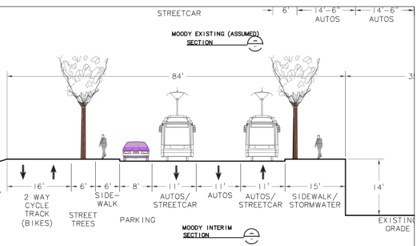
“The cycle track and pedestrian connections are essential elements of this project.”
— From a statement about TIGER grant issued today by Mayor Adams
In my report on the federal stimulus TIGER grant announcements this morning, I forgot an important detail about the only project in Oregon to get funded. The $23 million SW Moody and street reconstruction project (a.k.a. Portland’s Innovation Quadrant) includes a two-way cycle track.
I wrote about this new cycle track back in June and Mayor Sam Adams’ spokesperson Roy Kaufmann reminded me today that these TIGER funds mean the cycle track will now be built.
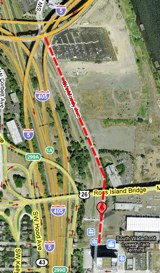
location of cycle track.
The grant will allow PBOT to begin a reconstruction of SW Moody Avenue from SW River Parkway to SW Gibbs Street. The new street will carry three standard traffic lanes, dual streetcar tracks, facilities for walking, and a two-way cycle track.
The new cycle track on SW Moody will connect riders to new bike facilities planned on TriMet’s new light rail bridge over the Willamette and the future Gibbs Street Pedestrian Bridge.
According to a statement released by Adams today, “The cycle track and pedestrian connections are essential elements of this project.” Currently, the only cycle track in Portland is on SW Broadway near Portland State University. Another cycle track is already planned as part of a reconstruction of Cully Boulevard in Northeast Portland.
Construction on the project will begin in fall of this year. For more information visit PDXInnovation.com.


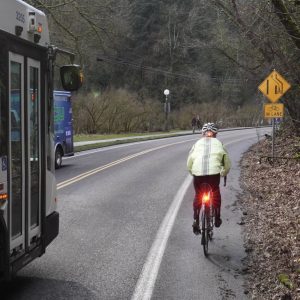
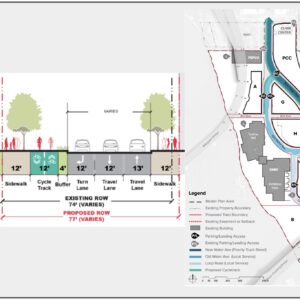
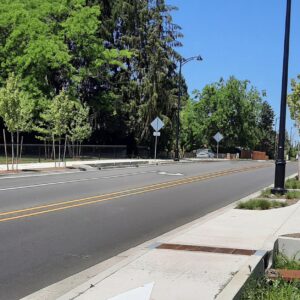
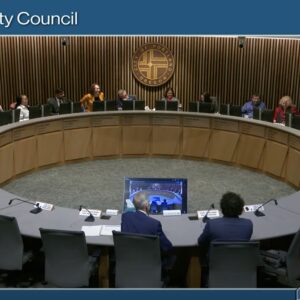
Thanks for reading.
BikePortland has served this community with independent community journalism since 2005. We rely on subscriptions from readers like you to survive. Your financial support is vital in keeping this valuable resource alive and well.
Please subscribe today to strengthen and expand our work.
Sweet! That will make any treks from my Downtown apartment into the SE Powell area a helluva lot easier (not to mention safer).
good: bicycles get a cycle track,
bad: streetcar gets put back on the street (currently this section of rail is off of the street and therefore the only part of the line that moves at a decent pace)
Ed,
Another (possibly larger) part of the reason that the Streetcar goes so slow is because of the many stops it makes. The Streetcar wasn’t really ever intended to move quickly, rather it was intended to be a bit faster than walking.
I typically outrun the Streetcar when I’m walking to my destinations. 🙂
Hopefully this will include traffic signals for bicycles as well, that prevent motorized interference at intersections.
I hope they mark the bicycle track WELL so people understand its intended use. It’ll be fun dodging joggers, dogs on leashes, etc.
Too bad the City is still $40m short. Nothing beats rebuilding a project that was just built, oh, about 5 years ago.
@AK #5: No doubt jaywalking enforcement needs to be done for the cycletrack to operate effectively. Same could be said for the Esplanade, Willamette Greenway and Springwater where pedestrians insist on walking down the center instead of towards the edges or on the shoulders…
It’s important to note that the Esplanade is a MUP, or Multi Use Path so it’s wise to expect random walkers, jogger, roller bladers, kids, photo taking tourists, etc. While gosh it’d be rad if everyone was respectful and aware, it’s impossible to achieve. I actually think it’s a *good* thing that there’s a place where the rules are less rigid, even if it slows one mode down a bit.
I do share the frustration of scrubbing off nearly all of the cargo bike’s precious momentum because other users are not paying attention. But I accept it because it’s a MUP and it beats the surface streets. If I need to rally and it’s a nice day, I avoid the Esplanade and take to the streets. I like rain.
Meanwhile, on a dedicated cycletrack there is intentional separation of modes. I don’t expect enforcement so I hope that the design is such that it will be clear where each user belongs AND each user actually goes there. I suspect it’ll run quite smoothly most of the time with the occasional random lost citizen wandering where they shouldn’t.
It’ll be a cool experiment. Boulder, Colorado has an amazing network of routes that I’d love to see copied here where applicable. Many of the intersections are grade separated so cyclists can roll across town without stopping. Imagine blazing across Sandy or 99/MLK without stopping because you’re rolling through a tunnel or bridge. The Boulder system is a MUP but it’s very cyclist dominant so it feels like a cycletrack.
@Zaphod #8, maybe the whole MUP concept is, by definition, a flawed concept that needs to be phased out. AFAICT, all existing MUPs have room for a sidewalk or jogging track so they don’t have to wander down the middle of the street.
“It’ll be fun dodging joggers, dogs on leashes, etc”
What ever happened to “share the road”?
Just jesting, it is frustrating to have joggers out in the traffic lanes when they have sidewalks right there and I have to pass in unsafe places
As previously mentioned, I think the solution to “dodging joggers, dogs on leashes, etc.” on the cycle track would be to make it poignant where the cycle lane is and where the pedestrian lane is, just like on the Hawthorne Bridge.
I walk across the Hawthorne quite often (a lot of the times with my dogs…on leashes!) and always keep to the right as the signage denotes. Rarely do I ever see any pedestrians breaking this “rule”, but I could be in the exception.
Jim @10: Exactly.
And while we’re at it, how about using “runner” instead of “jogger”? Language matters. Especially in this town where runners are a serious lot. Just like cyclists are.
Runners often run on the road rather than the sidewalk because sidewalks are notoriously cracked, uneven and littered with leaves or debris that can send a runner to their knees. This is even more true when the it’s dark or when lighting is haphazard.
Jackattak, I don’t think “poignant” is the word you’re looking for, but I do agree with your sentiment. (Although, looking it up on dictionary.com, you may mean it the sense of definition #1D or 1E….) 🙂
If it’s made very clear where each type of “getting around” is supposed to do their thing, this could work really quite well.
And yeah: They’re RUNNERS, not JOGGERS. My bro gives me crap about that all the time. But then again, he’s a runner. 🙂
Great news. Build it!
@ Kt # 14 –
Yep, “apparent” or “obvious” would’ve been much better choices.
I’ve been working on my book a lot lately and I tripped over my own feet in my desire to use better vocab.
🙂
Jonathan, can you post or link to larger images of the graphics in this article?
Northwest Girl #13
So runners go in the street and joggers stay on the sidewalk? Is it ok if runners use the cycletrack? Going the wrong way obviously and they would have right of way so all bikes do yeild to them?
Paul Johnson #7:
Indeed, while in Germany 6 years ago I myself walked into the bike “sidewalks” without realizing it until someone almost nailed me on a bike. I had simply just never seen them before and wasn’t thinking.
I think it’s easy to just simply not understand what they are for, not out of malice, but simply lack of education.
I would think ample bike path signage spray-painted on the cycle track would help… “bikes only”, “warning: fast bicycle traffic”, etc.
Sorry sorry, “runners”! 🙂
I don’t do either so the words are interchangeable to me, but I’ve had an Ironman friend correct me before as well when I’ve said jogging, ha. I should know better.
I agree with Paul (#9) that the MUP concept isn’t working too well, though for exactly the opposite reason. Too many people on bikes have too little respect for anyone else on the path, and insist on treating any place a bike can go as an area appropriate for urban assault riding without regard for the safety and comfort of adults, children, pets, the disabled, or even themselves.
Whatever happened to “Bikes Are Traffic”? If you’re operating a vehicle, you shouldn’t be mixing it up with pedestrians unless you’re prepared to operate at pedestrian speeds whenever and wherever appropriate. Separated bikes lanes, cycletracks, etc. — anything that keeps bikes on roads and off sidewalks, while also making it safer and faster for cycling commuters to reach their destinations safely and quickly — are great ideas; MUPs are not. We need to ban bikes from places like the Willamette Greenway and Waterfront Park, or start ticketing the many riders who can’t behave themselves until they learn to do so. Parks should belong to people, not to vehicles (motorized or not).
Michael M. #21:
I agree that cyclists need to learn how to operate their vehicles properly when mixing with foot traffic… you can’t zoom at 20 MPH through waterfront park. Waterfront park is a particularly bad place to ride through during the day anyways, and walking your bike for that 1 mile segment won’t kill you.
However, on long MPU paths such as the Springwater corridor, I think people using those paths need to be aware that there are other types of traffic (such as bikes), and modify their behavior appropriately as well. Walking three-abreast across the path is not a friendly behavior for a MPU, for example.
Cyclists are certainly a problem, but not the only one.
Jim @ 18:
Runners don’t belong in the cycletrack and I’m not suggesting they run there. I am suggesting that cyclists be alert to the reasons why a runner might choose the street rather than the sidewalk and not be derisive about having to “dodge joggers.”
There are plenty of us who are multi modal. I am a serious runner (Olympian), a serious cyclist and also a car driver. Sharing the road (or MUP) without condescension and derision makes for a better experience for all.
“unless you’re prepared to operate at pedestrian speeds whenever and wherever appropriate”
top pedestrian speeds are 14-18 mph. thats a bit fast for a busy mup, imo.
“We need to ban bikes from places like the Willamette Greenway and Waterfront Park”
if pedestrian safety was your primary concern you would be talking about children not cyclists.
top pedestrian speeds are 14-18 mph. thats a bit fast for a busy mup, imo.
A 6-minute mile is 10 mph. But next time I see Usain Bolt on the Springwater, I’ll ask him to please slow down. For the children.
#13: How much do you have to fail at basic motor skills to negotiate a not-level sidewalk? I’ll call ’em runners around the time they can actually do so on a surface that doesn’t require a surface pristine enough to run a skateboard down.
#21: What’s wrong with installing sidewalks on the existing MUPs and converting them into cycletracks with sidewalks? That makes more sense than your idea, since the odds of getting people to not use Willamette Greenway or Katz Esplanade for their explicit purpose (nonmotorized transportation) in favor of their tertiary use (pedestrianized recreation) is approximately nil.
The problem with the blanket “MUP” concept is that it doesn’t distinguish between paths that are more appropriate as transit corridors (Springwater, Marine Dr., I-205 path, etc.) and those that aren’t (Waterfront Park, Willamette Greenway, Esplanade, for example). To A.K.’s (#22) point that everyone (riders and walkers) needs to adapt their behavior to what is appropriate for the environment, I think creating clear distinctions in users’ minds between these different paths that we now call “MUPs” will help a great deal in accomplishing this. There’s a material difference in the experiences of walking or cycling along Springwater vs. the Greenway that the term “MUP” obfuscates. Unfortunately, the Bike Master Plan does nothing to help. It notes the rise in risk of more bike/ped conflicts that result from crowding users travelling at such disparate speeds into the same space, it calls for separation of biking and walking facilities wherever possible, but it doesn’t say much about what to do when this isn’t possible. It also reflects the same bias that Paul (#27) has that all current MUPs are primarily transit-oriented corridors, which is something cycling advocates have been pushing for years. The original goal of the Willamette Greenway, according to the OHP, was “establishing parks and open spaces along the river.” The same article notes, “In 1975, the state department of Land Conservation and Development included the Willamette River Greenway as one of nineteen standards for state-wide planning. That meant open space, public access, native vegetation, and scenic views had to be considered when planning new developments.” Nada about transportation, motorized or nonmotorized. But this kind of revisionist history is taken as a given in the Bike Master Plan, because it suits the efforts of cycling advocates to insert bikes everywhere they possibly can.
Contrary to spare_wheel’s (#24) characterization, I’m not primarily concerned with pedestrian safety (though, of course, that’s important). I’m primarily concerned with livability. I’m concerned that there are relatively few places in Portland to enjoy long walks free of interference from vehicular travel — parts of Washington Park, parts of Forest Park, Smith & Bybee Lakes, nothing in the Central City, where the majority of people live or work. It has long been a cornerstone of good urban design and planning that people need open space. In the age of the automobile, that has meant (among other things) areas free of cars. Now that we are finally getting serious about the viability of nonmotorized transit, we need to recognize that we still need some areas free of bikes as well.
@Michael Andersen (Contributor) #21: I don’t see how the original purpose of waterfront park and the Willamette Greenway as a bicycle corridor are incompatible: Install a sidewalk on the half facing the river, divide the other half as a two lane cycletrack with regular crosswalks every block. It’s not like pedestrians can’t have a sidewalk or use the grass…